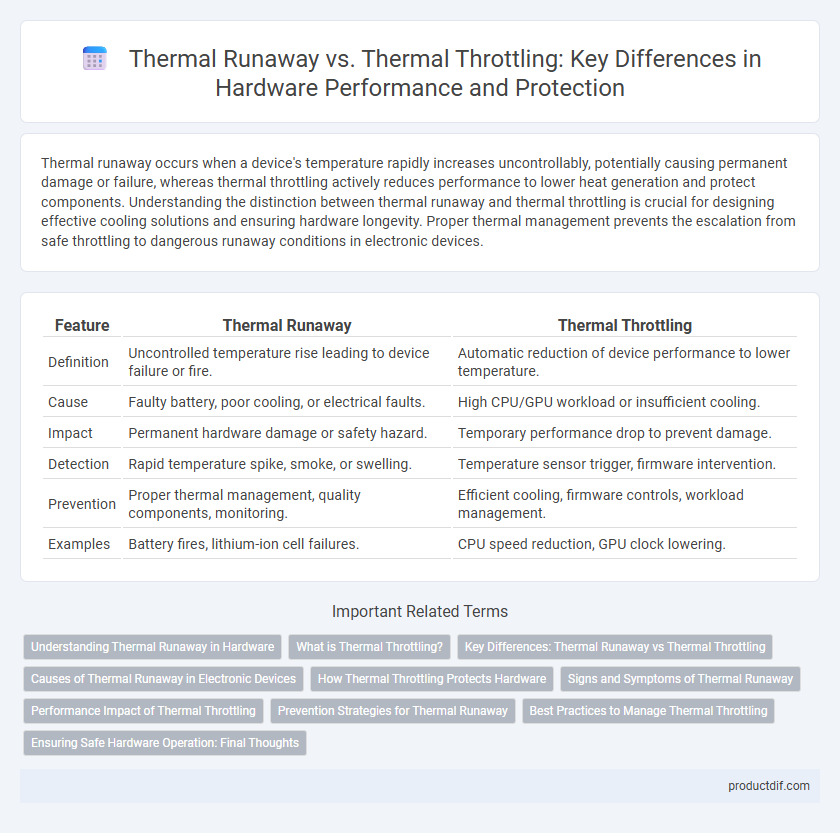Thermal runaway occurs when a device's temperature rapidly increases uncontrollably, potentially causing permanent damage or failure, whereas thermal throttling actively reduces performance to lower heat generation and protect components. Understanding the distinction between thermal runaway and thermal throttling is crucial for designing effective cooling solutions and ensuring hardware longevity. Proper thermal management prevents the escalation from safe throttling to dangerous runaway conditions in electronic devices.
Table of Comparison
| Feature | Thermal Runaway | Thermal Throttling |
|---|---|---|
| Definition | Uncontrolled temperature rise leading to device failure or fire. | Automatic reduction of device performance to lower temperature. |
| Cause | Faulty battery, poor cooling, or electrical faults. | High CPU/GPU workload or insufficient cooling. |
| Impact | Permanent hardware damage or safety hazard. | Temporary performance drop to prevent damage. |
| Detection | Rapid temperature spike, smoke, or swelling. | Temperature sensor trigger, firmware intervention. |
| Prevention | Proper thermal management, quality components, monitoring. | Efficient cooling, firmware controls, workload management. |
| Examples | Battery fires, lithium-ion cell failures. | CPU speed reduction, GPU clock lowering. |
Understanding Thermal Runaway in Hardware
Thermal runaway in hardware occurs when a device's temperature increases uncontrollably due to positive feedback, often leading to permanent damage or failure. Unlike thermal throttling, which actively reduces performance to lower heat, thermal runaway lacks effective thermal regulation and can cause catastrophic hardware breakdowns. Preventing thermal runaway requires robust cooling systems, accurate temperature sensors, and protective circuitry to maintain safe operating conditions.
What is Thermal Throttling?
Thermal throttling is a hardware mechanism designed to reduce the operating frequency and voltage of a component, such as a CPU or GPU, to prevent overheating and maintain safe temperature levels. This process helps protect the device from permanent damage by lowering performance temporarily, ensuring thermal limits are not exceeded during high workloads or inadequate cooling conditions. Unlike thermal runaway, thermal throttling is an intentional, controlled response to manage heat effectively within hardware systems.
Key Differences: Thermal Runaway vs Thermal Throttling
Thermal runaway occurs when increasing temperature causes a device to generate more heat uncontrollably, leading to potential hardware damage or failure, while thermal throttling is a protective mechanism where the device intentionally reduces performance to lower temperature and prevent overheating. Thermal runaway is a hazardous condition primarily associated with batteries and power electronics, whereas thermal throttling is commonly implemented in CPUs, GPUs, and other processors to maintain safe operating temperatures. Understanding the distinction helps in designing effective cooling systems and safety protocols in electronic hardware.
Causes of Thermal Runaway in Electronic Devices
Thermal runaway in electronic devices is primarily caused by excessive current flow leading to uncontrolled temperature increases, often due to inadequate cooling systems or defects in semiconductor materials. High power dissipation in components like transistors and batteries can initiate a feedback loop where rising temperatures reduce resistance, causing even more current and heat generation. Poor thermal management and environmental factors such as elevated ambient temperature further exacerbate this risk, distinguishing thermal runaway from thermal throttling, which is a controlled temperature regulation mechanism.
How Thermal Throttling Protects Hardware
Thermal throttling protects hardware by dynamically reducing the processor's clock speed to lower its temperature, preventing damage caused by excessive heat buildup. This mechanism activates before reaching thermal runaway, which is a dangerous, uncontrollable increase in temperature that can lead to permanent component failure. By maintaining optimal operating temperatures, thermal throttling extends hardware lifespan and ensures system stability under heavy workloads.
Signs and Symptoms of Thermal Runaway
Thermal runaway manifests through rapid and uncontrollable temperature rise in hardware components, often causing smoke, burning smell, or visible distortion of materials. Signs include sudden device shutdowns, swelling or bulging batteries, and abnormal heating despite cooling mechanisms operating properly. Detecting thermal runaway early is critical to prevent permanent damage or potential fire hazards in electronic devices.
Performance Impact of Thermal Throttling
Thermal throttling significantly reduces CPU and GPU clock speeds to prevent overheating, directly impacting system performance during intensive tasks by limiting processing power and causing lower frame rates or slower application responses. Unlike thermal runaway, which leads to hardware damage or failure, thermal throttling acts as a protective mechanism, balancing performance and temperature to maintain system stability. The effectiveness of thermal throttling depends on cooling solutions, device design, and workload intensity, making robust thermal management critical for sustained hardware performance.
Prevention Strategies for Thermal Runaway
Implementing high-quality thermal sensors and advanced monitoring systems is crucial for early detection and prevention of thermal runaway in electronic devices. Integrating robust cooling solutions, such as heat sinks and liquid cooling, effectively dissipates excess heat to maintain safe operating temperatures. Employing fail-safe circuits and automatic shutdown mechanisms serves as a critical defense to halt device operation when temperatures exceed predefined thresholds, mitigating the risk of catastrophic failure.
Best Practices to Manage Thermal Throttling
Effective management of thermal throttling involves optimizing cooling solutions such as high-performance heat sinks, quality thermal paste, and strategically placed fans to maintain lower CPU and GPU temperatures. Monitoring software with real-time temperature tracking and intelligent fan control settings ensures timely adjustments to prevent excessive heat buildup. Implementing power management profiles and regular hardware maintenance further reduces thermal runaway risks and enhances overall system stability.
Ensuring Safe Hardware Operation: Final Thoughts
Thermal runaway occurs when a device's temperature uncontrollably escalates, risking permanent hardware damage and potential safety hazards. Thermal throttling actively manages hardware temperature by reducing performance to prevent overheating and maintain system stability. Implementing effective cooling solutions and real-time temperature monitoring are crucial for safeguarding hardware longevity and ensuring safe operation.
Thermal runaway vs Thermal throttling Infographic

 productdif.com
productdif.com